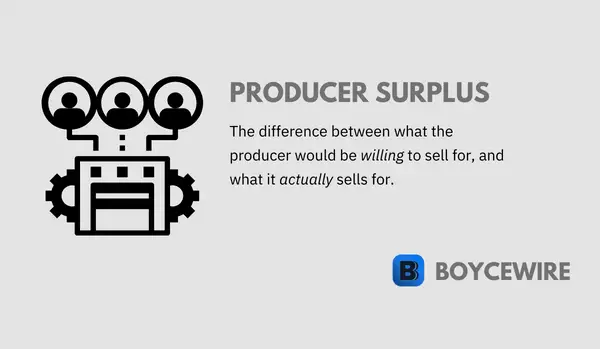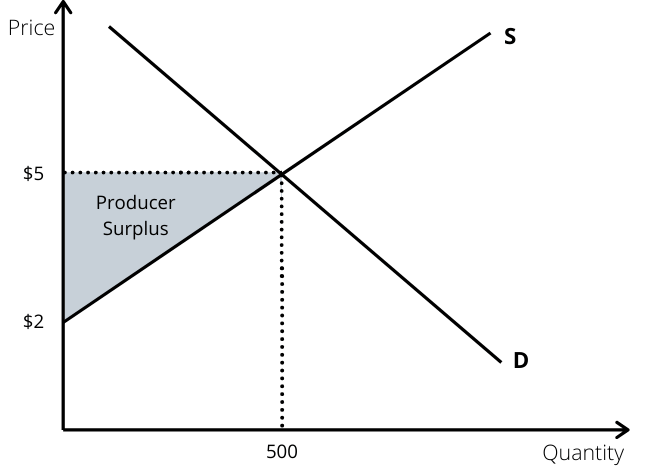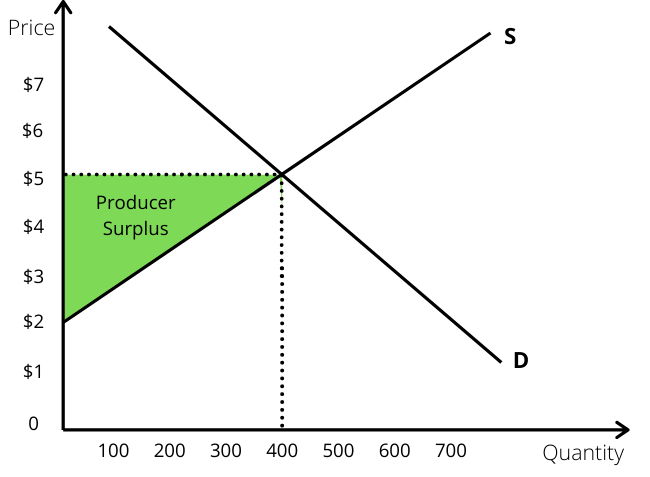Table of Contents ![]()
Producer Surplus: Definition, Formula & How to Calculate

What is Producer Surplus
The producer surplus refers to the profit that producers make from selling their goods or services at a price higher than what they would be willing to sell for. It is the difference between the minimum price the producer would accept and the actual selling price.
The producer surplus is a part of the overall economic surplus, along with the consumer surplus, which represents the benefit to society as a whole.
In economics, producer surplus is an important concept which helps understanding the topics of market efficiency and resource allocation. We will go on to look at how to calculate it, and look at some real-world examples.
Key Points
- Producer surplus is the amount that the producer benefits from selling above the price they would otherwise be willing to sell for.
- It can be calculated by taking total revenue and subtracting total cost.
- Producer and consumer surplus both amount to the total benefit to society – otherwise known as the economic surplus.
Let’s use McDonald’s as an example of producer surplus. The company may be willing to sell a Big Mac for $4, which is perhaps the cost to produce it. However, customers are willing to pay $7 for it, resulting in a producer surplus of $3. This $3 is the difference between what McDonald’s is willing to sell the Big Mac for and what the consumer is actually paying for it.
How to Calculate Producer Surplus
The producer surplus is the area between the price and supply curve, marked in grey on the graph below. This indicates the total surplus for all businesses in the market. Each business has a different minimum value and price, leading to varying surpluses.
Some businesses may have a surplus of $3, while others may only have a surplus of $1. The individual minimum selling point is usually the marginal cost. Anything above this cost is considered as the producer surplus, indicating that the business is selling above the production price.
The formula for calculating the producer surplus is Final Price – Marginal Cost.
Graph

Producer Surplus Formula
To calculate the total producer surplus, we must find the area of the triangle which is below the price, but above the supply curve. In order to calculate this, we use the following formula:

This simply calculates the square area between quantity and price, and then half this to find the area of the triangle. This formula calculates the total producer surplus – so the surplus for all the companies operating in a market.
If we want to find out the surplus on an individual business level, we can do this using the formula:
Quite simply, this is the profit that the individual business makes. After all, if the business is not making a profit, it will need to stop production. So anything it makes a profit on is essentially the producer surplus.
Producer Surplus Examples
In Country A, there are 500 coffee producers with varying production costs. The cost of production ranges from $2 to $5. At the point where supply and demand meet, known as equilibrium, coffee is sold at $5. The producer surplus is the difference between the price of coffee and the cost of production for each company.
Companies that produce at a cost lower than $5 make a surplus while companies producing at a cost of $5 make a loss instead of a surplus. For instance, the companies that produce at a cost of $2 are making a surplus of $3, while those with production costs of $4 make a surplus of $1.

On an individual business level, the surplus can vary, but the total surplus is shown on the graph in green. In this example, 400 bags of coffee are sold when the price is $5. That means hundreds of coffee producers obtain a surplus as it reflects the whole market.
To calculate the total surplus, we find out the quantity. In this case, 400 are sold. Then, we calculate the maximum surplus that is achieved. In this case, it is the price sold at, $5, take away the minimum price a producer would sell, $2 – which equals $3. The formula then equals 400 x $3, which equals $1,200. We then need to half this as it is a triangle, which brings the final producer surplus to $600.
Real-world Examples
Agricultural Markets
In agricultural markets, producer surplus is crucial for understanding the financial well-being of farmers. When market prices for crops are high, producer surplus increases, providing farmers with additional income. This extra income can be used for investments in new technologies or improvements to existing infrastructure, ultimately benefiting the agricultural sector as a whole.
Government Interventions
Government interventions, such as subsidies or taxes, can also impact producer surplus. For example, a subsidy provided to producers can increase the market price of a good, leading to a higher producer surplus. Conversely, a tax imposed on the production of a good can reduce the market price and consequently decrease producer surplus.
Market Efficiency and Producer Surplus
Market efficiency is an important concept in economics. It looks at how markets can most optimally perform in order to produce the best social results. Producer surplus is the amount that producers make over and above the minimum they would sell for. It is because of this surplus that markets can become efficient.
Markets are efficient when prices adjust quickly to changes in supply and demand, thereby leading to market equilibrium. However, the producer surplus is an important factor in making this happen. For instance, when there is a surplus, it sends a signal to other players in the market that there are profits to be had. This in turn encourages competition into the market, thereby bringing it back into equilibrium.
However, it’s important to note that this doesn’t necessarily always happen in the market. Sometimes companies have too much control, governments intervene, or various other external factors. All of which can contribute to making the market less efficient, thereby lowering the producer and total surpluses.
When there is excessive market power which is concentrated among a few firms, this can increase the producer surplus, whilst decreasing the consumer surplus. Companies are able to extract additional profits, whilst consumers pay a higher price. This makes for an inefficient market as supply and demand does not fall back into equilibrium.
There are also government actions which can lead to inefficient markets. For instance, taxes and subsidies can affect the producer surplus by either making goods more expensive or cheaper. This can artificially alter prices which don’t reflect its true cost – thereby leading to a more inefficient market. This might be because higher taxes mean producers make less profits, so have less of an incentive to produce more. Perhaps the firm needs to make a large investment to increase production. However, because profit margins are lower, it is not incentivised to do so.
Related Topics
FAQs
The producer surplus is the difference between what the producer sells its goods for and the minimum price it would be willing to sell for.
A producer surplus is good in the fact that it creates a profit for the producer. In turn, this creates an incentive for them to continue production. Without such, firms would not serve the market with many going out of business.
On an individual business level, producer surplus can be calculated using the formula: Producer surplus = total revenue – total cost.
On a macro level, we need to calculate the area beneath the price and above the supply curve. This is similar as to how you would calculate the area of a triangle: 
About Paul
Paul Boyce is an economics editor with over 10 years experience in the industry. Currently working as a consultant within the financial services sector, Paul is the CEO and chief editor of BoyceWire. He has written publications for FEE, the Mises Institute, and many others.

Further Reading
 Mercantilism: Definition, Characteristics & Examples - Mercantilism is an economic policy whereby a nation aims to maximize exports and minimize the imports.
Mercantilism: Definition, Characteristics & Examples - Mercantilism is an economic policy whereby a nation aims to maximize exports and minimize the imports.  Asset Turnover Ratio - The asset turnover ratio measures a company's efficiency in utilizing its assets to generate revenue by calculating the ratio of…
Asset Turnover Ratio - The asset turnover ratio measures a company's efficiency in utilizing its assets to generate revenue by calculating the ratio of…  Egalitarianism: Definition, Types & Example - Egalitarianism is the philosophic idea that all individuals are born equal and should be treated in such a way.
Egalitarianism: Definition, Types & Example - Egalitarianism is the philosophic idea that all individuals are born equal and should be treated in such a way. 